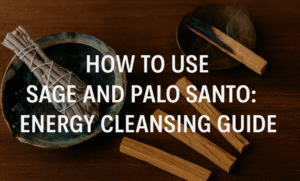When Your Space Feels Heavy
There are days when your home feels different. The air seems heavier. Your favorite corner doesn’t bring you the same peace. Conversations feel tense, and even sitting quietly doesn’t bring the calm you expect. If you’ve experienced this, you may have been feeling the energetic residue left behind from stress, conflict, or simply the demands of everyday life. This is where spiritual cleansing practices step in — and two of the most talked about are smudging and energy clearing.
At first glance, they might seem like the same thing. Both involve removing negative or stagnant energy from a space or person. But in truth, smudging vs energy clearing reveals important differences in origins, tools, and intentions. Understanding these differences can help you choose the right practice for your needs — whether you’re a student needing focus, a professional wanting a fresh workspace, or a spiritual seeker creating a sanctuary at home.
Why Smudging and Energy Clearing Matter Spiritually and Emotionally
Your environment influences your mood, focus, and emotional well-being. Just as dust and clutter affect how a space feels physically, stagnant energy can affect how it feels spiritually. Ancient cultures recognized this long before the modern wellness movement.
Smudging is a sacred practice rooted in Indigenous traditions, often using the smoke of burning plants such as sage, cedar, or sweetgrass to cleanse a person, place, or object. It’s deeply ceremonial, with respect paid to its spiritual origins. Energy clearing, on the other hand, is a broader term that encompasses many methods of shifting and refreshing energy — from sound healing and crystal placement to salt cleansing and intention-based visualization.
When I first moved into my apartment, I felt unsettled even though it was clean and beautifully arranged. I decided to try smudging with white sage, focusing on the corners of each room and my own aura. The difference was noticeable — the air felt lighter, my sleep improved, and my creativity began to flow again. Months later, I experimented with non-smoke-based energy clearing, using sound bowls and a saltwater bowl in the living room. The effect was different but equally powerful, helping me feel calmer and more grounded after stressful workdays.
Both methods work — but they work in distinct ways.
The Origins and Principles of Smudging
Smudging is not just a wellness trend; it is a sacred ceremonial act with deep cultural meaning. Native American and First Nations communities have practiced smudging for centuries as a way to connect with the spiritual realm, honor ancestors, and clear away negative influences. Traditionally, smudging is performed with prayer or spoken intention, and the smoke is believed to carry the cleansing energy upward.
In many traditions, the act involves lighting a bundle of dried herbs, allowing it to smolder, and gently wafting the smoke around the body, object, or space. The herbs chosen carry specific energetic properties — sage for purification, cedar for protection, sweetgrass for inviting positive spirits.
Spiritual teachers emphasize that smudging should be approached with respect for its origins. Using it without awareness of its sacred roots can lead to cultural appropriation. However, when practiced respectfully, smudging can be a profound way to cleanse and realign your personal or shared space.
The Broader Practice of Energy Clearing
Energy clearing is a wider umbrella of practices designed to release stagnant or negative energy from a person, object, or environment. While smudging is one form of energy clearing, many others exist — and they don’t necessarily involve smoke.
You might clear energy using sound, such as ringing a bell or playing a singing bowl. Some prefer crystals like black tourmaline or selenite, which are believed to absorb or deflect negativity. Others use salt water bowls to neutralize heavy vibrations in a room. Even visualization — picturing a bright light filling your home and sweeping away anything unwanted — can be a form of energy clearing.
Energy clearing practices are flexible, making them accessible to people who cannot use smoke due to health concerns, building restrictions, or personal preference. They also allow for personalization — you can combine methods, adapt them to your belief system, and create a cleansing ritual that feels uniquely yours.
Smudging vs. Energy Clearing – A Side-by-Side Look
| Aspect | Smudging | Energy Clearing |
|---|---|---|
| Origins | Rooted in Indigenous spiritual traditions | Found across multiple cultures and methods |
| Tools | Dried herbs (sage, cedar, sweetgrass) | Can include sound bowls, crystals, salt, visualization, smudging |
| Method | Burning plants to produce cleansing smoke | Broad range of techniques, often no smoke involved |
| Primary Purpose | Purification and spiritual connection | Removing stagnant energy, restoring balance |
| Best For | Ceremonial or deeply spiritual cleansing | Everyday refresh, personal adaptation |
| Cultural Considerations | Requires awareness and respect for sacred origins | More flexible, varied cultural roots |
How to Know Which Practice is Right for You
Choosing between smudging and energy clearing depends on your needs, environment, and personal values. If you’re drawn to ceremonial rituals and can use smoke safely, smudging may feel deeply satisfying. If you live in an apartment, share space with others, or prefer a non-smoke approach, energy clearing offers countless options.
When I was working from home during a particularly intense period, I alternated between both. Smudging became my “deep clean” — done at the start of each month or after emotionally heavy events. Energy clearing became my “light maintenance” — sound bowls in the morning, a saltwater bowl on my desk, and occasional visualization at night. The combination kept my home feeling peaceful and creatively inspiring.
A Respectful Approach to Smudging
If you choose to smudge, approach it with reverence. Learn about its cultural significance from authentic Indigenous sources. Purchase herbs sustainably and ethically. Begin with a clear intention — not simply “removing bad vibes” but inviting peace, clarity, and alignment into your space.
Before lighting your bundle, take a moment to center yourself. As the smoke rises, move it gently through your space, paying attention to corners, doorways, and windows. You might silently express gratitude for the cleansing, acknowledging the tradition you are honoring.
A Flexible Approach to Energy Clearing
Energy clearing gives you room to explore and adapt. Some mornings, I walk through my space ringing a small brass bell to “wake up” the energy. Other times, I use palo santo, a fragrant wood from South America, which has its own cleansing and uplifting qualities. On stressful days, I find sound baths particularly soothing — the vibration of crystal bowls seems to wash through me, leaving a sense of renewed clarity.
The beauty of energy clearing is its adaptability. You can create a practice that fits your lifestyle and evolves with your needs.
Expert Insight on Energy Practices
Astrology.com notes that “cleansing rituals align your personal energy with your environment, creating harmony between the two.” AstroStyle emphasizes that intention is the most important factor — the tools you choose are less critical than the mindset you bring. Energy healers often remind us that cleansing isn’t about fear of “negative energy” but about aligning with what supports your well-being.
Research in environmental psychology also supports the idea that rituals — whether smudging, sound clearing, or visualizing light — can shift mood, reduce stress, and create a greater sense of control over your surroundings.
Final Thoughts – Choosing Your Path to Clarity
In the discussion of smudging vs energy clearing, there’s no winner or loser. Both offer ways to refresh your space and realign your energy. Smudging connects you to a lineage of sacred ceremony, offering deep purification and spiritual grounding. Energy clearing opens the door to flexibility, allowing you to tailor your approach to your environment, beliefs, and lifestyle.
Your practice doesn’t need to be one or the other. You might reserve smudging for significant transitions — moving into a new home, starting a new chapter in life, or after challenging events. You could use energy clearing for regular upkeep, weaving it into your daily or weekly routine.
Ultimately, the goal is the same: to live in spaces — inner and outer — that support your peace, clarity, and highest potential. Whether through the rising smoke of sage or the gentle chime of a bell, you are choosing to make your environment a sanctuary for your spirit.
FAQs
Is smudging safe for everyone?
Not always. People with respiratory conditions, pets, or sensitive smoke alarms may want to avoid or limit smudging.
Can energy clearing replace smudging?
Yes. Energy clearing offers many alternatives that can be just as effective without using smoke.
How often should I cleanse my space?
There’s no strict rule. Some cleanse weekly, others only after stressful events or major life changes.




